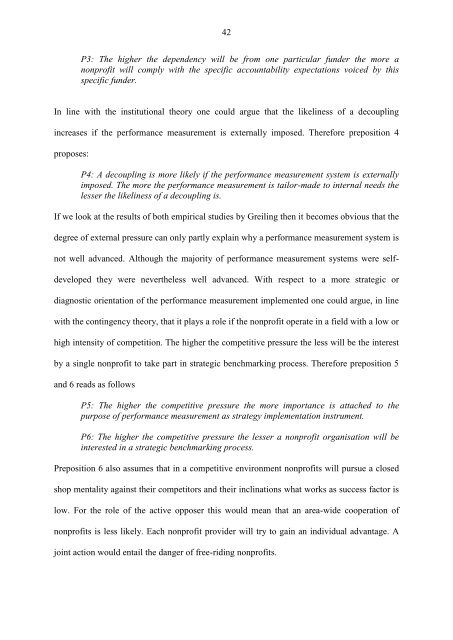Strategic responses to Performance Measurement in Nonprofit ...
Strategic responses to Performance Measurement in Nonprofit ...
Strategic responses to Performance Measurement in Nonprofit ...
Create successful ePaper yourself
Turn your PDF publications into a flip-book with our unique Google optimized e-Paper software.
42<br />
P3: The higher the dependency will be from one particular funder the more a<br />
nonprofit will comply with the specific accountability expectations voiced by this<br />
specific funder.<br />
In l<strong>in</strong>e with the <strong>in</strong>stitutional theory one could argue that the likel<strong>in</strong>ess of a decoupl<strong>in</strong>g<br />
<strong>in</strong>creases if the performance measurement is externally imposed. Therefore preposition 4<br />
proposes:<br />
P4: A decoupl<strong>in</strong>g is more likely if the performance measurement system is externally<br />
imposed. The more the performance measurement is tailor-made <strong>to</strong> <strong>in</strong>ternal needs the<br />
lesser the likel<strong>in</strong>ess of a decoupl<strong>in</strong>g is.<br />
If we look at the results of both empirical studies by Greil<strong>in</strong>g then it becomes obvious that the<br />
degree of external pressure can only partly expla<strong>in</strong> why a performance measurement system is<br />
not well advanced. Although the majority of performance measurement systems were self-<br />
developed they were nevertheless well advanced. With respect <strong>to</strong> a more strategic or<br />
diagnostic orientation of the performance measurement implemented one could argue, <strong>in</strong> l<strong>in</strong>e<br />
with the cont<strong>in</strong>gency theory, that it plays a role if the nonprofit operate <strong>in</strong> a field with a low or<br />
high <strong>in</strong>tensity of competition. The higher the competitive pressure the less will be the <strong>in</strong>terest<br />
by a s<strong>in</strong>gle nonprofit <strong>to</strong> take part <strong>in</strong> strategic benchmark<strong>in</strong>g process. Therefore preposition 5<br />
and 6 reads as follows<br />
P5: The higher the competitive pressure the more importance is attached <strong>to</strong> the<br />
purpose of performance measurement as strategy implementation <strong>in</strong>strument.<br />
P6: The higher the competitive pressure the lesser a nonprofit organisation will be<br />
<strong>in</strong>terested <strong>in</strong> a strategic benchmark<strong>in</strong>g process.<br />
Preposition 6 also assumes that <strong>in</strong> a competitive environment nonprofits will pursue a closed<br />
shop mentality aga<strong>in</strong>st their competi<strong>to</strong>rs and their <strong>in</strong>cl<strong>in</strong>ations what works as success fac<strong>to</strong>r is<br />
low. For the role of the active opposer this would mean that an area-wide cooperation of<br />
nonprofits is less likely. Each nonprofit provider will try <strong>to</strong> ga<strong>in</strong> an <strong>in</strong>dividual advantage. A<br />
jo<strong>in</strong>t action would entail the danger of free-rid<strong>in</strong>g nonprofits.
















